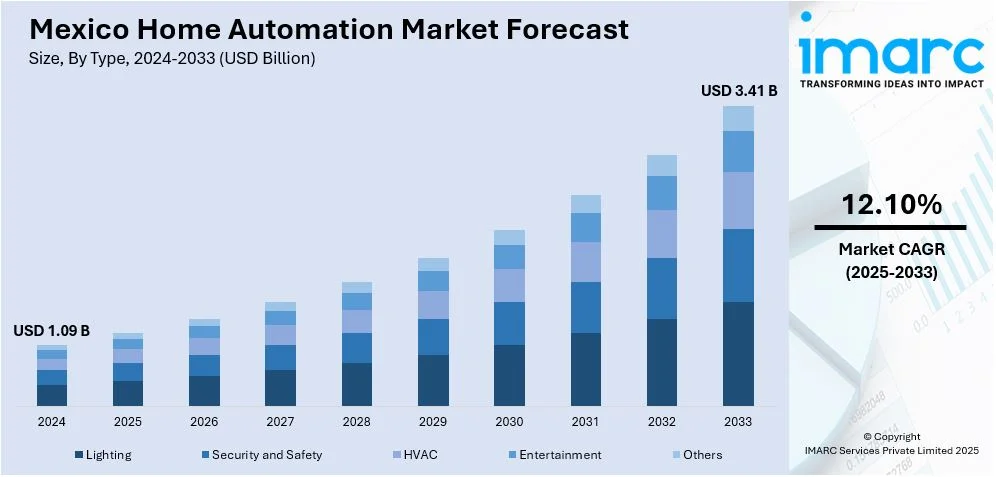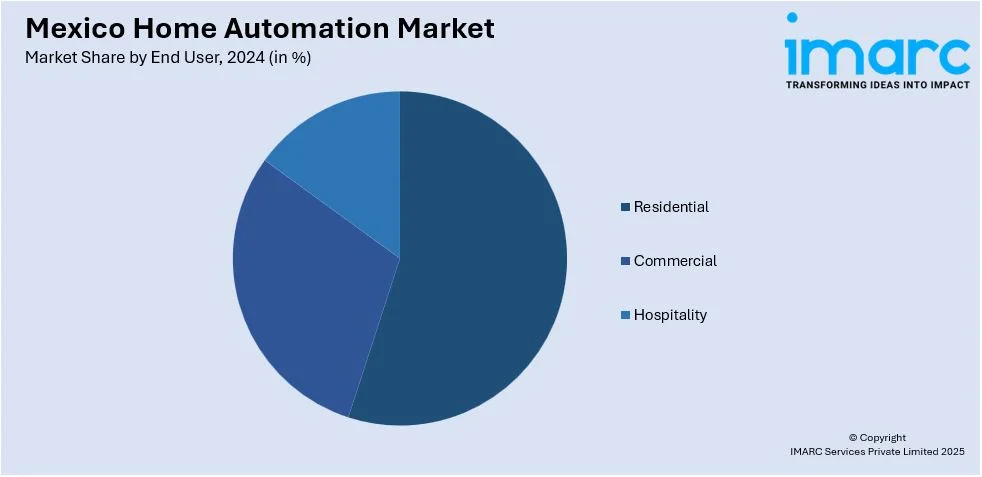
Mexico Home Automation Market Size, Share, Trends and Forecast by Type, Technology, End User, and Region, 2025-2033
Mexico Home Automation Market Overview:
The Mexico home automation market size reached USD 1.09 Billion in 2024. Looking forward, IMARC Group expects the market to reach USD 3.41 Billion by 2033, exhibiting a growth rate (CAGR) of 12.10% during 2025-2033. The rapid rate of urbanization and rising middle-class income are increasing demand for smarter, more efficient houses. Additionally, improved internet connectivity across the country, energy efficiency capabilities, and increasing concern about home security are propelling the market growth. Apart from this, voice assistants like Alexa and Google Home, government initiatives promoting digital infrastructure and modern housing, real estate development in cities such as Mexico City and Guadalajara, and an aging population are factors boosting the Mexico home automation market share.
|
Report Attribute
|
Key Statistics
|
|---|---|
|
Base Year
|
2024 |
|
Forecast Years
|
2025-2033
|
|
Historical Years
|
2019-2024
|
| Market Size in 2024 | USD 1.09 Billion |
| Market Forecast in 2033 | USD 3.41 Billion |
| Market Growth Rate 2025-2033 | 12.10% |
Mexico Home Automation Market Analysis:
- Major Market Drivers: Rapid urbanization and rising middle-class incomes are driving the Mexico home automation market. Expanding internet connectivity and awareness of energy efficiency and home security encourage smart system adoption. Households increasingly integrate automated solutions to enhance convenience, safety, and energy savings, supporting sustained growth and long-term market expansion nationwide.
- Key Market Trends: Voice assistants, smart thermostats, automated lighting, and security systems define Mexico home automation market trends. Wireless technologies are preferred for installation ease, while AI-enabled modular systems deliver cost-effective, customizable solutions. Middle-class households increasingly adopt these innovations, reflecting evolving consumer preferences, convenience demands, and technological integration in everyday residential settings across Mexico.
- Competitive Landscape: The Mexico home automation market comprises domestic and international players providing diverse solutions. Companies emphasize affordability, localization, and energy optimization. Innovation in AI-driven and modular systems enhances functionality, while strategic partnerships expand distribution and adoption. Competitive efforts focus on meeting rising consumer demand and strengthening presence across multiple residential segments.
- Challenges and Opportunities: Rural infrastructure gaps challenge market penetration, but government digital initiatives and urban housing projects present opportunities. Aging populations increase demand for assisted living technologies, while real estate growth supports automation adoption. Economic stability, rising consumer awareness, and sustainable technology trends further drive expansion, positioning the market for long-term growth and development.
Mexico Home Automation Market Trends:
Rising Urbanization
The urbanization in Mexico has been rising consistently, and as of 2023, 81.58% of the population is residing in urban areas. The urbanization has been driven by industrialization, economic policies, and urbanization campaigns. The urban population growth rate per year was 1.2184% in 2023, and it indicates there is a continual pattern of urbanization. Major cities like Mexico City, Guadalajara, and Monterrey have witnessed significant growth in their population, which has propelled the demand for modern infrastructure and services. Urban growth in these cities has created opportunities for the home automation market, as urban residents are requesting more convenience, security, and energy efficiency in their homes. The concentration of population in urban areas allows the adoption of smart home technologies due to greater availability of internet connectivity and technical infrastructure. The government's focus on urbanization and housing developments also supports the Mexico home automation market demand trend. Urban lifestyle enhancement initiatives largely encompass the application of intelligent technologies, promoting the adoption of home automation systems, which is further driving the Mexico home automation market growth.

To get more information on this market, Request Sample
Growing Middle-Class Income
Mexico's middle class has also made notable gains, with its population standing at around 42.2% belonging to this socioeconomic group. The increase results from a number of factors that range from greater access to education, economic reforms, and urbanization. The middle class household income is between USD 1,500 and USD 2,500 per month, providing them with improved purchasing power. This growth in disposable income has led to changes in consumption patterns, as middle-class households spend more on education, healthcare, and housing. The demand for smart home technologies follows these priorities, as households seek to enhance their quality of life through automation and enhanced home management. Economic stability, fueled by the expansion of the middle class, also fuels the adoption of new technologies, supporting the Mexico home automation market outlook with sustained growth prospects.
Enhanced Internet Connectivity
Mexican internet access has increased significantly, with 100.6 million users as of early 2023, an increase from a penetration rate of 78.6%. This is an increase of 4.6 million users compared to the previous year, showing the massive expansion in digital access. The growth is also confirmed by the 14 million additional internet users acquired between 2020 and 2023. Such advances facilitate the use of smart home devices, which rely on secure and quick internet connectivity. The increased connectivity enables homeowners to adopt technologies such as smart thermostats, security systems, and voice assistants, making home automation solutions more appealing. The growth in access to the internet, particularly in urban areas where 81.6% of the population has access, is an enabling market for the Mexico home automation market forecast sector.
Mexico Home Automation Market Segmentation:
IMARC Group provides an analysis of the key trends in each segment of the market, along with forecasts at the country and regional levels for 2025-2033. Our report has categorized the market based on type, technology, and end user.
Type Insights:
- Lighting
- Relay
- Dimmers
- Switches
- Others
- Security and Safety
- Bells
- Locks
- Security Cameras
- Others
- HVAC
- Thermostats
- Sensors
- Control Valves
- Others
- Entertainment
- Home Theater System
- Audio, Volume, and Multimedia Controls
- Others
- Others
The report has provided a detailed breakup and analysis of the market based on the type. This includes lighting (relay, dimmers, switches, others), security and safety (bells, locks, security cameras, others), HVAC (thermostats, sensors, control valves, others), entertainment (home theater system, audio, volume, and multimedia controls, others), and others.
Technology Insights:
- Wired
- Wireless
A detailed breakup and analysis of the market based on the technology have also been provided in the report. This includes wired and wireless.
End User Insights:

- Residential
- Commercial
- Hospitality
The report has provided a detailed breakup and analysis of the market based on the end user. This includes residential, commercial, and hospitality.
Regional Insights:
- Northern Mexico
- Central Mexico
- Southern Mexico
- Others
The report has also provided a comprehensive analysis of all the major regional markets, which include Northern Mexico, Central Mexico, Southern Mexico, and Others.
Competitive Landscape:
The market research report has also provided a comprehensive analysis of the competitive landscape. Competitive analysis such as market structure, key player positioning, top winning strategies, competitive dashboard, and company evaluation quadrant has been covered in the report. Also, detailed profiles of all major companies have been provided.
Mexico Home Automation Market News:
- In 2024, Mexican home automation startup Domotic Design launched an AI-powered modular smart home system, that adjusts energy consumption using learning algorithms in small homes and apartments. It aims at middle-class families with systems priced 30% cheaper than foreign brands.
Mexico Home Automation Market Report Coverage:
| Report Features | Details |
|---|---|
| Base Year of the Analysis | 2024 |
| Historical Period | 2019-2024 |
| Forecast Period | 2025-2033 |
| Units | Billion USD |
| Scope of the Report |
Exploration of Historical Trends and Market Outlook, Industry Catalysts and Challenges, Segment-Wise Historical and Future Market Assessment:
|
| Types Covered |
|
| Technologies Covered | Wired, Wireless |
| End Users Covered | Residential, Commercial, Hospitality |
| Regions Covered | Northern Mexico, Central Mexico, Southern Mexico, Others |
| Customization Scope | 10% Free Customization |
| Post-Sale Analyst Support | 10-12 Weeks |
| Delivery Format | PDF and Excel through Email (We can also provide the editable version of the report in PPT/Word format on special request) |
Key Benefits for Stakeholders:
- IMARC’s industry report offers a comprehensive quantitative analysis of various market segments, historical and current market trends, market forecasts, and dynamics of the Mexico home automation market from 2019-2033.
- The research report provides the latest information on the market drivers, challenges, and opportunities in the Mexico home automation market.
- Porter's five forces analysis assist stakeholders in assessing the impact of new entrants, competitive rivalry, supplier power, buyer power, and the threat of substitution. It helps stakeholders to analyze the level of competition within the Mexico home automation industry and its attractiveness.
- Competitive landscape allows stakeholders to understand their competitive environment and provides an insight into the current positions of key players in the market.
Key Questions Answered in This Report
The home automation market in Mexico was valued at USD 1.09 Billion in 2024.
The home automation market is projected to exhibit a CAGR of 12.10% during 2025-2033, reaching a value of USD 3.41 Billion by 2033.
Key factors driving the Mexico home automation market include rapid urbanization, rising middle-class incomes, improved internet connectivity, growing awareness of energy efficiency, and increasing demand for smart security solutions, fostering widespread adoption of automated systems across residential spaces.
Need more help?
- Speak to our experienced analysts for insights on the current market scenarios.
- Include additional segments and countries to customize the report as per your requirement.
- Gain an unparalleled competitive advantage in your domain by understanding how to utilize the report and positively impacting your operations and revenue.
- For further assistance, please connect with our analysts.
 Request Customization
Request Customization
 Speak to an Analyst
Speak to an Analyst
 Request Brochure
Request Brochure
 Inquire Before Buying
Inquire Before Buying




.webp)




.webp)












